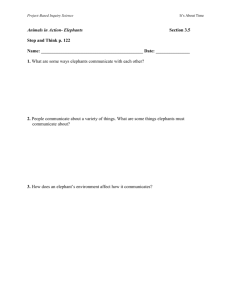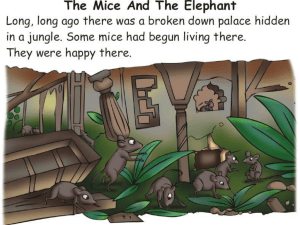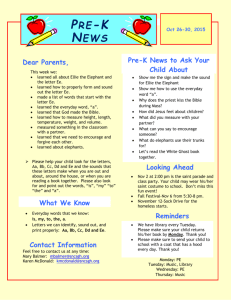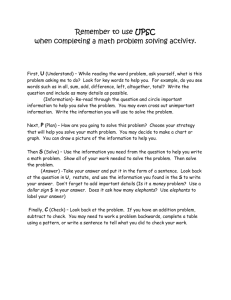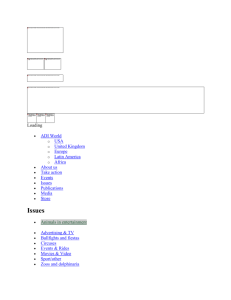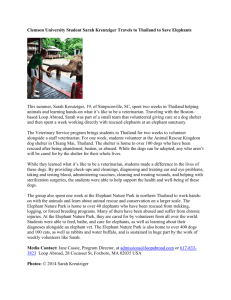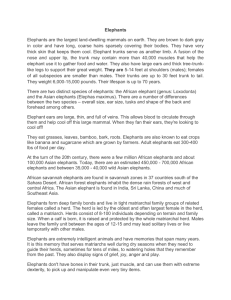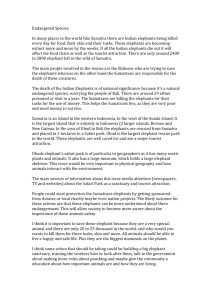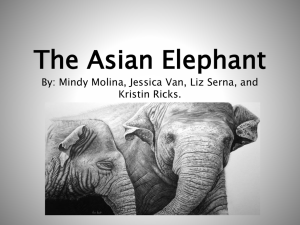The Elephant Family
advertisement
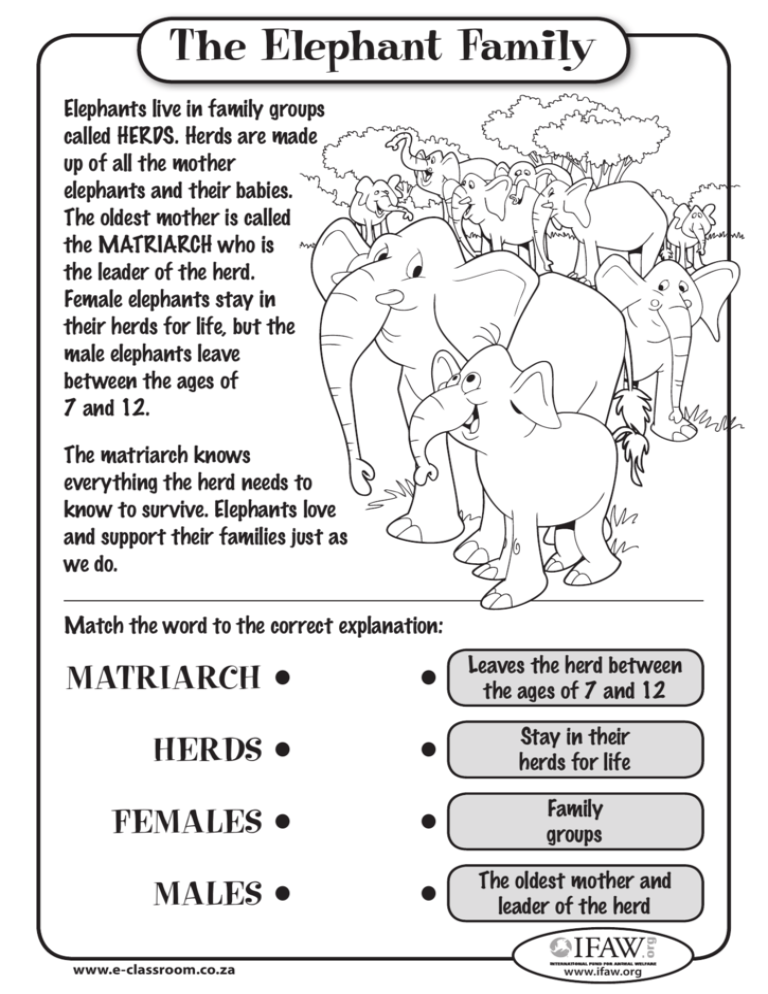
The Elephant Family Elephants live in family groups called HERDS. Herds are made up of all the mother elephants and their babies. The oldest mother is called the MATRIARCH who is the leader of the herd. Female elephants stay in their herds for life, but the male elephants leave between the ages of 7 and 12. The matriarch knows everything the herd needs to know to survive. Elephants love and support their families just as we do. Match the word to the correct explanation: • Leaves the herd between the ages of 7 and 12 • Stay in their herds for life FEMALES • • Family groups MALES • • The oldest mother and leader of the herd MATRIARCH • HERDS • www.e-classroom.co.za www.ifaw.org Baby Elephants A baby elephant is called a calf. They only stand about 3 feet tall when they are born and stay very close to their mothers for the first few months. They start to eat plants from about four months but still drink their mother’s milk for at least another 2 years or more. At first, baby elephants do not know how to use their trunks and can even step on them! From 6-8 months, they learn to use their trunk to eat and drink and by the time they are a year old, they can use their trunks very well. Draw a picture of your own baby elephant in the space below. What name are you going to give your elephant? My baby elephant’s name is: ............................................................................................................................... Answers:1. plant eaters; 2. 16-20 hours per day; 3. get fruit and leaves from trees www.e-classroom.co.za www.ifaw.org Elephant Appetites Elephants are plant eaters, or HERBIVORES. They eat leaves, roots, grasses, bark and fruits. They spend 16-20 hours a day eating! Elephants use their trunks to get fruit and leaves from trees. They use their trunks to pull down trees and their tusks to pull the bark off trees. Elephants drink water only once or twice a day. Colour the picture then answer the following questions by ticking the correct box. 1.Elephants are: n plant eaters n meat eaters 2.Elephants can eat up to: n 2 hours per day n 16-20 hours per day 3.Elephants use their trunks to: n get fruit and leaves from trees n sit on Answers:1. plant eaters; 2. 16-20 hours per day; 3. get fruit and leaves from trees www.e-classroom.co.za www.ifaw.org Spot the Difference FOREHEAD HAS TWO HUMPS There are two main groups of elephants: the African elephant and the Asian elephant. Study the pictures to learn about these differences, then colour the picture. EARS DO NOT COVER THE SHOULDER TALLEST AT ARCH OF BACK Asian FIVE TOES ONE LOBE OF FLESH ON TIP OF TRUNK FOUR TOES TALLEST AT SHOULDER BACK DIPS FOREHEAD CURVES SMOOTHLY African EARS COVERS THE SHOULDER TWO LOBES OF FLESH ON TIP OF TRUNK FOUR OR FIVE TOES www.e-classroom.co.za SKIN IS LOOSER AND MORE WRINKLED THREE TOES www.ifaw.org Comprehension Read the story then answer the questions below using the word bank to help you. Then colour the picture. There are two main groups of elephants. They are the African and Asian elephant. The African elephant has two different species – the forest and savannah elephants. A savannah is a grassland. All elephants are herbivores and live in family groups called herds. A matriarch is the leader of the herd and usually the oldest female. She is the one who keeps the group together. 1.Name the two main groups of elephant: ................................................................................................................... and .................................................................................................................. 2.The two species of African elephant are forest and .......................................................................... 3.All elephants are .................................................................................................................. 4.All elephants live in family groups called ................................................................................................................. 5.The leader of the herd is called the ............................................................................................................................... . 6.The matriarch is usually the ............................................................................................................................... female. African • Asian • savannah herbivores • herds • matriarch • oldest Answers:1. African, Asian; 2. savannah; 3. herbivores; 4. herds; 5. matriarch; 6. oldest www.e-classroom.co.za www.ifaw.org Elephant Word Search Find the elephant words hidden in the word search. Remember they can be horizontal, vertical, diagonal or backwards. Colour the pictures. african • asia • elephants • herds fruit • leaves • bark • tusks • trunk ears • matriarch • calf • plants c s b n a c i r f a t a d j k l a p r o c v t r u n k u u f s a b i e r i b i y m e l e p h a n t s h a a f k r o l n e t r u s k s u t e v n s t n a l p e s a b p j i n a i s a e h c r a i r t a m l www.eclassroom.co.za www.ifaw.org Elephant Story Write your own elephant story or poem. Use the words in the word bank to help you. herds • families • matriarch • trunk • tusk teeth • ears • leaves • roots • fruit • bark www.e-classroom.co.za www.ifaw.org Jumbo Jumble Look at the picture below - it’s all jumbled up! Cut out the pieces along the dotted lines and then put the picture back together as shown in the diagram at the bottom of the page. Colour the picture once you have assembled it correctly. Now see if your friends can do the puzzle. www.e-classroom.co.za www.ifaw.org Quick on the Draw Learn how to draw an elephant by following the easy step-by-step numbers. Draw your own elephant in the space provided then colour your picture. 1 7 2 8 3 5 4 6 9 10 11 12 13 Did you draw an African or Asian elephant? ....................................................................................................... Answer: African www.e-classroom.co.za www.ifaw.org Elephant Paper Plate Make your own elephant face. You will need: •Paper plate •Glue •Scissors •Coloured pencils Trace or cut out the eyes, ears and trunk below and glue them to the paper plate as shown in the diagram. www.e-classroom.co.za www.ifaw.org
